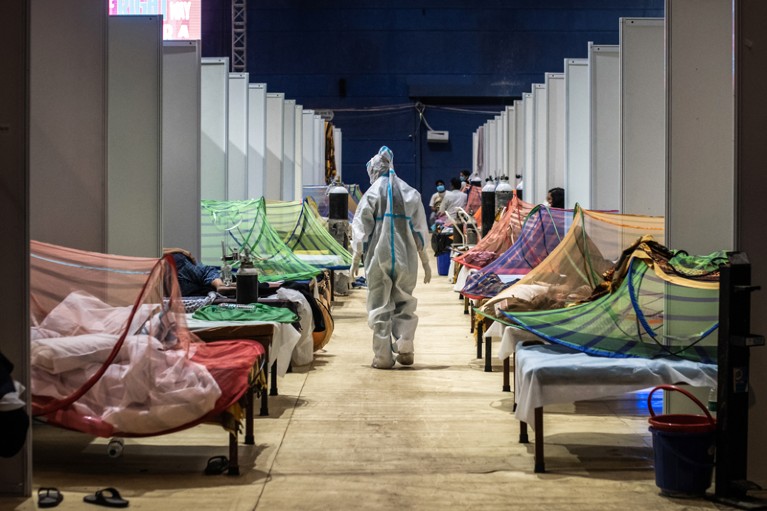
A medical worker observes people with COVID-19 inside a makeshift care facility at the Commonwealth Games Village in New Delhi in May 2021.Credit: Getty
There were high hopes for 2021. The year promised progress on the push for sustainable development after months of pandemic-induced delays and uncertainty. We heard ambitious talk of a ‘green recovery’, and world leaders were due to gather for meetings of the United Nations conventions on biological diversity and on climate to set future agendas.
How did the year’s sustainability debates evolve? We take a look through Nature’s science lens.
2021: a year of multiple crises
As 2021 draws to a close, the world is facing numerous crises. The COVID-19 pandemic is far from over. A year after the first vaccines began to clear regulatory hurdles, the emergence of the SARS-CoV-2 Omicron variant is challenging the fragile and unequal gains in bringing the virus under control. Progress is slow on mitigating and adapting to climate change, protecting biodiversity and ending hunger — parts of the Sustainable Development Goals (SDGs), the United Nations’ flagship plan to end poverty and promote a healthier planet by 2030. The plan, already off track before the pandemic, has been all but derailed by COVID-19.
More floods, fires and cyclones — plan for domino effects on sustainability goals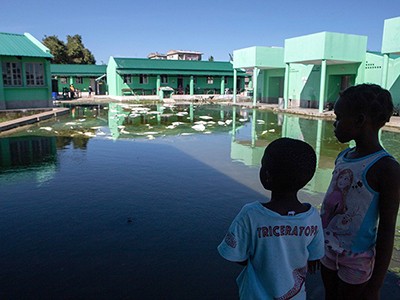
Nature has argued1 that the setback requires a more rapid response by the researchers who are writing the latest UN Global Sustainable Development Report — the scientific input to the SDGs, which runs on a four-year cycle. But attempts to feed science into policy have come up against strong barriers. Democracy and multilateralism are in retreat, undermining the commitment needed to make progress on sustainability goals. Still, this should not be a reason to disengage. On the contrary, researchers generally need to redouble their efforts.
Fighting the climate crisis
Early November was marked by a momentous climate summit, the 26th UN Climate Change Conference of the Parties (COP26) in Glasgow, UK. For the first time, the final agreement included mention of a phase down of coal-fired power, although phase out was the original aim. It also called for the ending of some public subsidies for other fossil fuels — one of the biggest financial barriers to the shift to renewable energy. More than 100 countries pledged to cut methane emissions, flagged for their role in global warming in the latest report from the Intergovernmental Panel on Climate Change (IPCC)2. Richer nations committed to doubling their funding by 2025 to help low- and middle-income countries (LMICs) deal with the damage already caused by climate change, and they agreed to set up an office to research a long-proposed fund to compensate LMICs for that damage.
But even if the pledges announced are implemented, temperatures are still projected to rise to a catastrophic 2.4 °C by 2100. And below the surface lay disagreements on definitions and the detail of implementation. And this is where research must continue to offer essential input. ‘Net-zero’ is one example. There is no agreed definition or measure of it, and without this, it’s impossible to know whether pledges will actually stop global warming. There is also no agreed definition of climate finance for LIMCs. This means that richer countries can make up their quotas with loans or official development aid that links to climate change only indirectly. Arguments have persisted for years over the funding promised more than a decade ago — what has been disbursed and who owes what — and this has undermined trust and has cast a shadow over negotiations, including those in the lead-up to the Glasgow meeting.
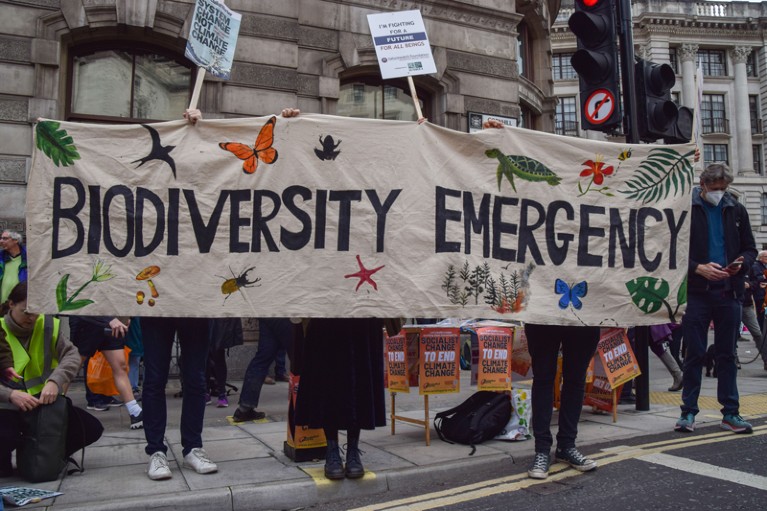
Protesters hold a ‘Biodiversity Emergency’ banner during the demonstration outside the Bank of England in London in November 2021.Credit: Vuk Valcic/SOPA Images/LightRocket/Getty
Elusive biodiversity protection
Just days before COP26, at a separate COP hosted by China in Kunming in Yunnan province, governments debated measures to protect the diversity and richness of plant and animal species. In the first sessions of a two-part UN summit on biological diversity, due to conclude in May 2022, discussions centred on a widely supported target to protect 30% of the world’s land and sea areas by 2030 — up from the previous ‘Aichi target’ of 17%. Among other targets under debate was the provision of greater financial support to low-income countries to preserve biodiversity.
The world’s species are playing musical chairs: how will it end?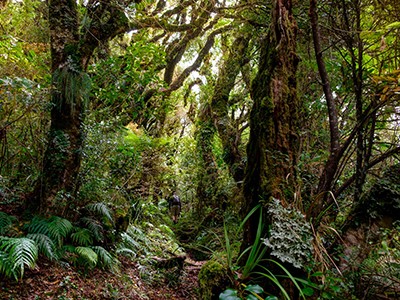
Progress on biodiversity protection has proved elusive since the first ‘Earth Summit’ in Rio de Janeiro in 1992. The Kunming summit ended with a modest boost in funding for projects that help to preserve biodiversity — unlike climate change, funding for biodiversity comes mostly from the public sector. We argued that these contributions should be given as grants, rather than loans that saddle poor countries with debt3. This is now more important than ever, as the pandemic piles perilous debt on the developing world.
Protecting biodiversity goes hand in hand with managing land and water resources sustainably, and in this way aligns with tackling climate change. And if nature continues to degrade, sooner or later economic output will suffer. This link is captured by debates over assigning monetary and other values to ecosystems, an idea no longer theoretical or controversial. In March, we welcomed a move by members of the UN Statistical Commission to finalize a set of principles that will help national statisticians record ecosystem health and work out payments for ecosystem services4.
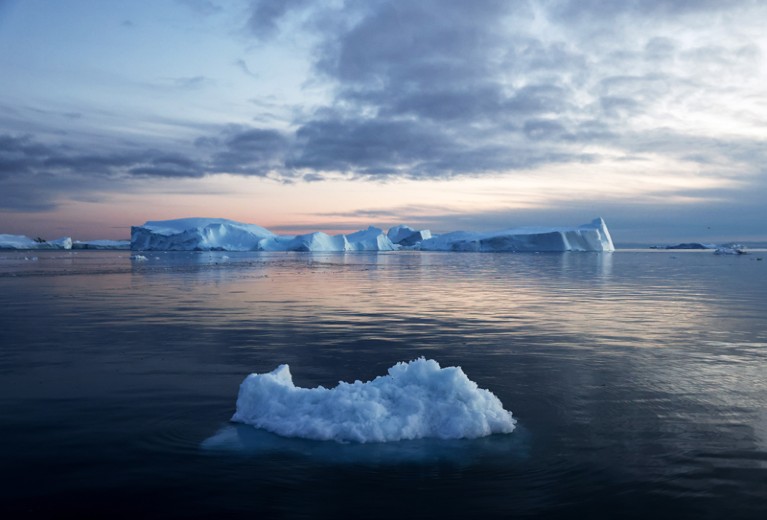
Icebergs that calved from the Sermeq Kujalleq glacier in Greenland this year help mark one of Greenland’s biggest ice-melt years in recorded history.Credit: Mario Tama/Getty
Revamping food systems
Like biodiversity protection, the world’s food system needs fixing. One in ten people is undernourished and one in four is overweight. The number of people going hungry is rising fast, a trend fuelled by the pandemic. Nature’s coverage emphasizes the fact that science needs to guide the transformation of the food system. The task is challenging, because food spans many disciplines. We have yet to pin down what diets that are both healthy and sustainable should look like. And an IPCC-like system of scientific advice to inform policymaking has so far been missing from food and agriculture.
What humanity should eat to stay healthy and save the planet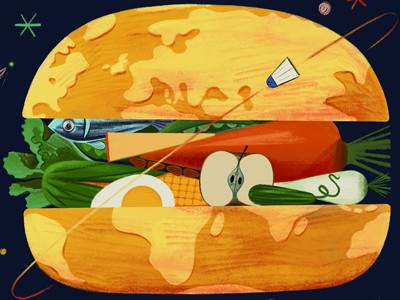
That changed in September, when António Gutteres, the UN secretary-general, convened a controversial but historic Food Systems Summit. A group of scientists was tasked with ensuring that the science underpinning the summit was robust, broad and independent. Writing in Nature, this scientific group issued seven priorities for research, among them a greater focus on sustainable aquatic foods5. Soil-based agriculture tends to dominate discussions on food, with ‘blue foods’ — organisms such as fish, shellfish and seaweeds — rarely considered.
Nature joined the scientific group’s call to argue that it’s time to change that (see go.nature.com/3e3ss6r). We published the Blue Food Assessment — the first systematic evaluation of how aquatic food contributes to food security — which explores how research can help transform the global food system. This work also shows some pitfalls of a greater reliance on blue foods without sustainable management, as a rapidly increasing demand for fish adds to risks for coastal ecosystems and the people of coastal communities.

Volunteers prepare meals for distribution in the Paraisopolis favela in São Paulo, Brazil, in March 2021Credit: Jonne Roriz/Bloomberg/Getty
Strong moves from the UN’s centre
The year 2021 also saw various arms of the UN consider how their own governance needs to respond and adapt to changing times. Guterres is set to appoint a new board of scientific advisers to his office, a decision that Nature welcomed6. The decision is part of the organization’s 25-year vision, laid out in the secretary-general’s report, Our Common Agenda (see go.nature.com/3egrudq), in September. Specialized agencies also needed to stocktake. Over the fifty years since its founding, the UN Environment Programme has pushed important initiatives that bring science into ‘green’ policy — co-founding the IPCC, for one — and we urged it to do more to bring together researchers from across environmental sciences to tackle interconnected challenges7. Nature also urged the International Monetary Fund’s shareholders to lend money to strengthen universities, so that science can better work towards global goals8.
The broken $100-billion promise of climate finance – and how to fix it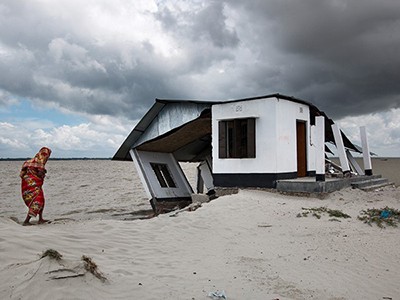
The right moves at the top echelons of global governance matter – but support for science and collaboration within and between countries matter just as much. In some ways, LMICs are leading the way. A 700-page report by the UN science and cultural organization UNESCO is a first attempt to understand the impact of the SDGs on research priorities9. It found that, unlike richer nations, lower-income countries’ share of research publications jumped in areas such as photovoltaics and climate-resilient crops. Individual countries need to do better to boost innovation, but collaboration will prove crucial. We need look no further than the pandemic for examples of how researchers working across borders, cultures and disciplines can benefit science and society.
Collaboration and inclusion
We need — and can — do better on collaboration. Global problems need diverse teams to help navigate social and geopolitical challenges. Our COVID-19 coverage comes with a host of inspiring stories of scientists joining forces to tackle the crisis. It serves as a reminder of what can be done. But it’s not easy. Collaboration means spending less time achieving metrics of performance and more time nurturing relationships. Link-ups between science and industry suffer without rules around data ownership and intellectual property. And mounting geopolitical tensions, particularly between the United States and China, are limiting exchanges of people and knowledge10.
How the COVID pandemic is changing global science collaborations
The benefits of international research are worth the effort for both LIMCs and wealthy nations. But collaborations often come with concerns over equity and who benefits. Concerns over inclusion extend to policy forums too. At COP26, Nature found that researchers were frequently prevented by the organizers from accessing negotiations. Representatives from civil society and the global south also complained of exclusion. That experience must not be repeated. We’ve also argued that forums such as the G7 group of wealthy nations and the World Health Organization should regard emerging economies as equals. And UN bodies that solicit scientific input need to reach out beyond their usual expert networks to involve under-represented communities. The Food Systems Dialogues (see go.nature.com/3ykm2ye) could be a model: this initiative has engaged hundreds of participants across six continents since 2018, becoming an official mechanism to build international consensus at the UN food summit.
An eye on the future
Looking ahead to 2022, we’re keeping our finger on the pulse. Nature will maintain a focus on climate, global health and sustainability. We expect more attention to the food crisis and climate-related migration, and more debate on solutions and trade-offs tied up with the energy transition.
Why fossil fuel subsidies are so hard to kill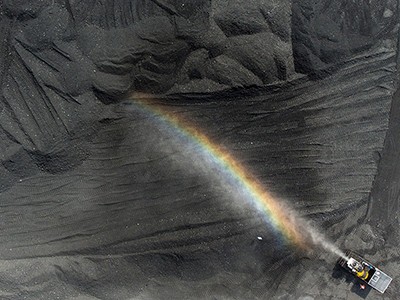
The fallout from the pandemic will be a key focus. It includes the burden of disability from long COVID, lost ground in the fight against polio, malaria, tuberculosis and HIV, the lifelong impact of the loss of education for millions of children, and rising violence against women and girls. As economies struggle to get back on their feet, the financing of sustainability goals is an urgent issue that needs resolving. Researchers should also work towards resolving some of the long-standing tensions between climate, biodiversity conservation and food provision.
The SDGs remain a holistic framework for guiding priorities for sustainable development. In the shorter term, we look to next year’s conclusion of the biodiversity summit, and the climate summit in Cairo. And we stand ready to support science as it responds to global challenges by engaging with policy and the public.

 Why fossil fuel subsidies are so hard to kill
Why fossil fuel subsidies are so hard to kill
 The broken $100-billion promise of climate finance – and how to fix it
The broken $100-billion promise of climate finance – and how to fix it
 More floods, fires and cyclones — plan for domino effects on sustainability goals
More floods, fires and cyclones — plan for domino effects on sustainability goals
 How the COVID pandemic is changing global science collaborations
How the COVID pandemic is changing global science collaborations
 The world’s species are playing musical chairs: how will it end?
The world’s species are playing musical chairs: how will it end?
 What humanity should eat to stay healthy and save the planet
What humanity should eat to stay healthy and save the planet





